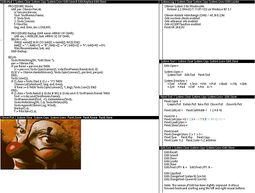- Oberon (operating system)
-
Oberon
Tiled window arrangement of OberonCompany / developer Niklaus Wirth and Jürg Gutknecht Programmed in Oberon Source model Free and open source software Initial release 1985 [1] Available language(s) English Supported platforms NS32032, several others Default user interface Text user interface License ETH Oberon License Official website www.oberon.ethz.ch Oberon is an operating system developed in the late 1980s at ETH Zürich using the Oberon programming language. It has an innovative visual text-based user interface for activating commands.
Contents
History
The Oberon operating system was originally developed as part of the NS32032-based Ceres workstation project. It is written almost entirely in the Oberon programming language.[2] The basic system was designed and implemented by Niklaus Wirth and Jürg Gutknecht and is fully documented in their book "Project Oberon".[3] It was later extended and ported to other hardware by a team at ETHZ. Wirth and Gutknecht (although being active ICT professors) referred to themselves as 'part time programmers' in the book 'Project Oberon'.
User interface
Oberon has a text user interface (TUI). It combines the point-and-click convenience of a graphical user interface (GUI) with the linguistic strength of a command line interface (CLI) and is closely tied to naming conventions of the Oberon language. Any text appearing on the screen can be edited and used as command input. Nothing like a prompt is required. Although radically different from a command line, the TUI is very efficient and powerful.[4] A steep ascent in the early learning curve makes it difficult to start with. Its usage and programming interface is documented in Martin Reiser's book "The Oberon System."[5] It has yet to appear in more commonplace operating systems, although it strongly inspired Rob Pike's Acme system under Plan 9. Whether the worksheet interface of the Macintosh Programmer's Workshop influenced Oberon's TUI or vice versa is difficult to decide since the Oberon System was based on Wirth's previous computer design the Lilith, and both the Apple Macintosh and the Lilith were inspired by the Alto.
Versions and availability
The Oberon OS is available for several other hardware platforms, generally in no cost versions. It is typically extremely compact. Even with an Oberon compiler, assorted utilities including a web browser, TCP/IP networking, and a GUI, the entire package fits on a single 3.5" floppy disk. The version which runs on bare PC hardware is called Native Oberon.
There is also a version called Oberon V4 that is closer to the original operating system developed by N. Wirth. It was also developed at ETHZ, but the most recent version is at Linz university. Oberon V4 appears to be orphaned, there are almost no changes since 2000.
The computer science department at ETHZ has in recent years begun exploring active objects and concurrency for operating systems, and has released an early version of a new language Active Object Oberon and a new operating system for it, first called AOS and now called A2 and/or Bluebottle. It is available from ETHZ with most source via the Internet. Versions are currently available for Intel IA-32 single and multi-processor systems and for the StrongARM CPU family.
As a part of an industrial research project[6] the Native Systems Group of ETHZ has developed an application-specific operating system called stailaOS which is based on the latest version Oberon OS. It is targeted towards applications like real-time analytics, high performance trading systems, main memory based ERP etc.
See also
References
- ^ ETH Zürich - Oberon page
- ^ M. Reiser and N. Wirth: Programming in Oberon Addison-Wesley/ACM Press (1992) ISBN 0-201-56543-9
- ^ N. Wirth and J. Gutknecht: Project Oberon - The Design of an Operating System and Compiler Addison-Wesley/ACM Press (1992) ISBN 0-201-54428-8
- ^ Franz, Michael. "Oberon - The Oberlooked Jewel" in Lászlo Böszörmény, Jürg Gutknecht, Gustav Pomberger (Eds.) "The School Niklaus Wirth - The Art of Simplicity". Morgan Kaufmann Publishers. (2000), pp. 41-53, ISBN 1-55860-723-4
- ^ Reiser, Martin: "The Oberon System - User Guide and Programmer's Manual" - Out-of-print - Addison-Wesley/ACM Press (1991) ISBN 0-201-54422-9
- ^ stailaOS(ETHZ) Project Page
External links
Categories:- Free software operating systems
Wikimedia Foundation. 2010.

